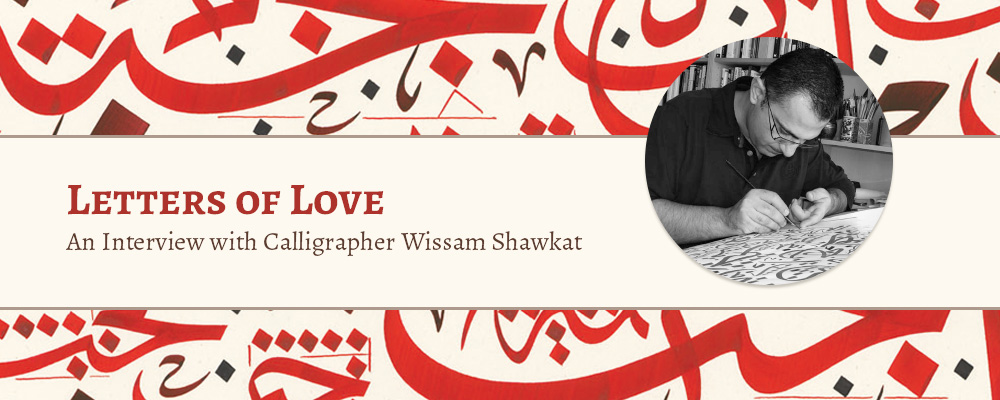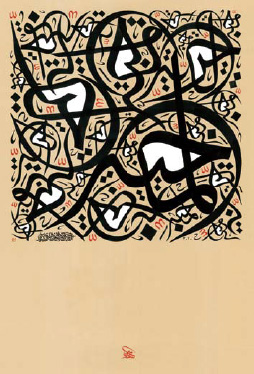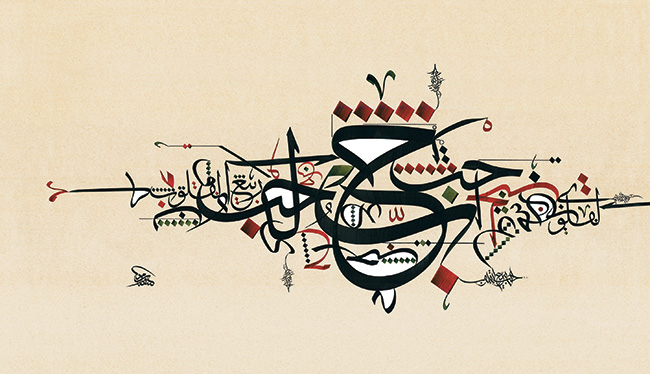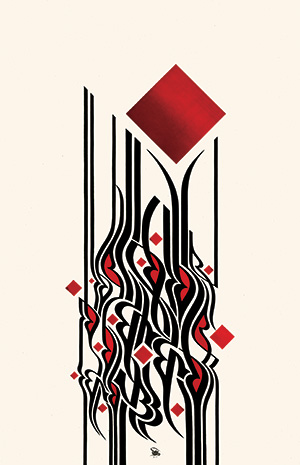
Arabic script calligraphy is the art of beautiful writing, using the letters of the Arabic alphabet. This art form is also known as Islamic calligraphy, because it was first developed to write the Qur’an—the holy book of Islam. Because of the sacred nature of the Qur’an, special care was taken in its transcription, and the art of calligraphy (Greek for “beautiful writing”) developed as a result.
Calligraphy is one of the most revered and respected forms of visual art in the Islamic world, since it serves as a vehicle through which to remember and contemplate God. Though the art form started in the Middle East, today it is practiced and enjoyed by people from many different countries and religions.
Elisabeth Kvernen’s interview today is with Wissam Shawkat, a Christian calligrapher originally from Iraq, who now lives in Dubai. Wissam has practiced calligraphy and design for over 20 years, and has received numerous accolades for his work. His unique style borrows from the exquisite craftsmanship of traditional practitioners and the vibrancy of contemporary Arab culture. His pieces are included in private and public collections throughout the world. Visit Wissam’s website to see more of his work.

Love & Freedom | Love is the only freedom in the world – Khalil Gibran | 95 X 63 cm | Soot ink and acrylic colors on Handmade paper | 2010
When and how did you become interested in calligraphy?
I fell in love with calligraphy in 1984, during an art class. My primary school teacher (Mohammad Ridha Suhail), who was also a calligrapher and an artist, wrote some calligraphy in the Ruqa’a script on the black board. From that moment, the beauty of Arabic letters as calligraphy captivated me; it became an obsession.
The same year, my father bought my elder brother a book about calligraphy (by Hashim Mohammed Al Baghdadi). My brother was not very interested in the subject, so he gave the book to me, and I spend hours looking at the pages. I still have this book today.
Can you describe your calligraphy style? Traditional? Modern? In-between?

The Love Garden | 55 X 95 cm | Soot ink and acrylic colors on paper | 2010
My current work bridges classical and traditional calligraphy. While much of my work has a modern look and feel, I still practice and create traditional calligraphy. Over the past ten years I have created my own script, which I call Al Wissam. It is a new calligraphic script based on several historic styles (Sunbuli, Jali Diwani, Eastern Kufic, and Thuluth), and it has a contemporary look. I believe that in order to break the rules, you need to master them first, so I have used the traditional styles and rules as a point of departure for something new.
What do you enjoy most about being a calligrapher?
I love being able to make a living pursuing an art form that I am passionate about.
Arabic script calligraphy is one of the highest art forms in Islam, developed primarily to preserve the Qur’an. What is it like to be a Christian practicing this art form?
As a Christian Arab from an Arab country (Iraq), for me calligraphy is more connected with language than religion. However, without Islam, Arabic calligraphy would not have survived and prospered all these years.
I approach calligraphy as a pure art form—the art of beautiful writing. I was attracted to this art form for aesthetic reasons, and see calligraphy as a form of personal expression. While calligraphy was originally developed to preserve the Qur’an, I am more attracted to its graphic values; I see the letters as abstract shapes.
How do you choose the texts for your calligraphy compositions? What sources do you use?
I believe that the content of a calligraphy composition is as important as the look and feel of the calligraphy. I choose texts with a message that I believe in. I draw on sources all around me; if I find something interesting while reading, or in my daily life, I write it down. I have a notebook where I keep beautiful sayings—wisdom or poetry—and I look through it when choosing the text for a composition. I choose texts that are positive and meaningful, so I can reflect that in my composition and be inspired by it while writing the calligraphy.
Tell us more about your 2011 Letters of Love exhibition in New York City. How did a Western audience respond to your work?
The exhibition was very well received. I think Western audiences associate Arabic calligraphy with more traditional styles, and many people were surprised by how modern and graphic my work was. That was exactly what I wanted to achieve—first, to change the old-fashioned picture people have of Arabic calligraphy, and second, to show that even classically trained calligraphers using traditional scripts can create artwork with a modern sensibility. [See the exhibition brochure.]
One of the pieces in the exhibition (Love 4) was inspired by the city of New York. In the piece the word “love” is written many times using a dynamic, curvy, repeated lines. When creating this artwork, I imagined I was looking at Manhattan from above, and tried to capture the energy of the streets. The diamond-shaped red dots are like looking at skyscrapers from above. New York City holds a special place in my heart; I had a fantastic time there in 2011 for my debut exhibition in the United States.
All images courtesy of Wissam Shawkat.
Like this post? Subscribe to have new posts sent to you by email the same day they are posted.





This is so incredibly beautiful! You encourage me to buckle down and continue practising calligraphy. I confess I get discouraged at trying to get it right. Thank you for sharing your gift w/ the world.